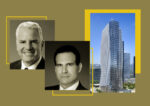It’s official. Office tenants in Downtown Los Angeles are clearing their office desks for tonier digs in Century City, Pasadena and El Segundo.
Business tenants have shifted half or more of their employees from offices in Downtown to outlying areas, while maintaining a presence in DTLA, Bisnow reported, citing CBRE Executive Vice President Jeffrey Welch.
Welch said it was once common for such firms to keep 75 percent of L.A. workers in Downtown and 25 percent on the Westside. That has shifted. In many instances, 75 percent work in Century City and just 25 percent in Downtown, he said.
“Most companies are doing what I would call quiet leaves or quiet downsizes of Downtown,” Welch told Bisnow. “They’re not leaving it. They’re keeping footprints.
“Whether it’s a bank, a law firm, a consultant firm, a lot of companies have downsized their footprint and grown in either Century City or other suburban markets, and I think that’s not a trend that’s going to stop,” he said. “I think it’s going to get worse before it gets better.”
Last month, Wedbush Securities, which has leased Downtown offices since 2001, announced it would move to Pasadena next year. Its new offices are 80 percent smaller than the space it will leave behind in DTLA.
Thousands of office workers have left Downtown, unlikely to return. Many shops and restaurants remain closed. Office tenants say the streets feel less safe than they once did.
Safety is what tenants want when making office decisions in today’s market, Welch said.
“As long as that remains an impediment, Downtown is swimming upstream,” he told Bisnow.
Century City is often described as the safe, clean alternative to Downtown. So is Pasadena and El Segundo.
Last summer, law firm Sidley Austin opted to downsize its Downtown offices by moving from the Gas Company Tower to a smaller office at Two California Plaza and to a $300 million tower under construction in Century City.
Downtown’s reduced desirability has meant that the balance between those offices has shifted.
Moving to a less central location means looking at employee location maps and employee commute patterns, Welch said, then using that information to select an office site outside Downtown.
Pasadena has emerged as a common landing pad for companies looking to leave Downtown behind, he said. “It’s a nice bedroom community with strong amenities and a better environment from a safety perspective,” he noted.
El Segundo, for its proximity to labor pools in the South Bay, has attracted attention from companies looking beyond Downtown, Welch said.
Downtown still has advantages.
“It’s still a central location, the center of all public transit, a key location for sports and entertainment — the Lakers, the Dodgers,” Welch told Bisnow. “It’s going to play a large part in the Olympics. So Downtown does have a future, but we’re struggling.”
The office vacancy in Downtown L.A. was 32.8 percent last quarter, with nearly 1.2 million square feet of negative net absorption, according to CBRE. Last year, the vacancy was 28.2 percent, with negative annual net absorption of 1.5 million square feet.
— Dana Bartholomew
Read more



